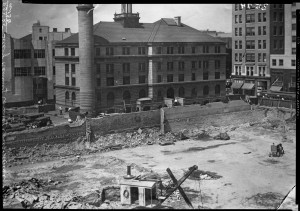You may not have time to visit a museum during your workday, but courthouse employees are often delighted to discover the what lies on the other floors of the building. We welcome these resident visitors to the law library, where they can appreciate historical and architectural details here, as well as the fantastic judge portrait collection. Stunning though the library space is, however, it is only the frosting on the cake of this this historic architectural confection. Indeed, for those who have never visited, entering the courthouse itself can feel like stepping onto a vintage movie set. This is why a formal tour is probably the best way to discover some of the lesser-known details of this building, and can easily be arranged by contacting the Ramsey County Historical Society.
The tour includes information on the historical beginnings of the courthouse. This present-day courthouse basically resulted from a general dissatisfaction with the previous courthouse, which was dedicated in 1889. Perhaps local leaders felt slightly embarrassed when a grand jury remarked in 1925 that the then-36-year-old courthouse was “antiquated, inconvenient, and an architectural mistake.” Surely the pressure was then on to build something not only beautiful for the community, but also something functional and timeless for future generations. After much planning and construction, the final result was our current courthouse, which was dedicated on November 21, 1932. (See this write-up of the festivities held that day.) Indeed this building has survived well beyond its novelty stage, as it was inducted into the National Register of Historical Places in 1983. (See also the original nomination form.)
What often gets overlooked in the courthouse is the impressive list of artistic masters showcased here. To start, the building was designed by Holabird & Root of Chicago and Thomas Ellerbe & Co. of St. Paul. Holabird and Root were masters then of what we call art deco, the style famous for sleekness of form and simplicity of ornament. The actual construction was performed by Foley Brothers, Inc. of St. Paul. The most obvious and familiar of the art installations is the onyx Indian God of Peace by Carl Milles, but fewer people may know that the actual hands-on carving was done by local St. Paul stonecutter John Garatti and his crew. The exterior stone decorations are the work of Lee Lawrie, who was the most successful American architectural sculptor of his time. (See this fantastic article about his work.) There are also the six bronze elevator doors which were made by Albert Stewart. The city council chambers feature murals which were painted by John W. Norton. For quick reference see this handy brochure of the artistic features throughout the courthouse and the people behind them.
Unfortunately, these walls can’t talk, so sign up for a tour to hear what they would tell you if they could!
